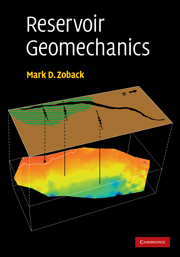Book contents
- Frontmatter
- Contents
- Preface
- PART I BASIC PRINCIPLES
- 1 The tectonic stress field
- 2 Pore pressure at depth in sedimentary basins
- 3 Basic constitutive laws
- 4 Rock failure in compression, tension and shear
- 5 Faults and fractures at depth
- PART II MEASURING STRESS ORIENTATION AND MAGNITUDE
- PART III APPLICATIONS
- References
- Index
- Plate section
5 - Faults and fractures at depth
Published online by Cambridge University Press: 10 December 2009
- Frontmatter
- Contents
- Preface
- PART I BASIC PRINCIPLES
- 1 The tectonic stress field
- 2 Pore pressure at depth in sedimentary basins
- 3 Basic constitutive laws
- 4 Rock failure in compression, tension and shear
- 5 Faults and fractures at depth
- PART II MEASURING STRESS ORIENTATION AND MAGNITUDE
- PART III APPLICATIONS
- References
- Index
- Plate section
Summary
In this chapter I consider a number of topics related to faults and fractures in rock. Faults and fractures exist in essentially all rocks at depth and can have a profound effect on fluid transport, mechanical properties and wellbore stability. As discussed in Chapter 4 (and later demonstrated through a number of case studies), frictional slip along pre-existing fractures and faults limits in situ stress magnitudes in a predictable – and useful – way.
To begin this chapter, I distinguish between opening mode (Mode I) fractures and faults, and briefly discuss the importance of faults in influencing fluid flow in low permeability rock. The influence of faults on permeability is discussed at length in Chapter 11, as well as the sealing (or leakage) potential of reservoir-bounding faults. The manner in which slip along weak bedding planes can affect wellbore stability is discussed in Chapter 10. I briefly discuss wellbore imaging devices as it is now routine to use such devices to map fractures and faults in reservoirs, and then discuss common techniques for representing fracture orientation data, including stereonets and three-dimensional Mohr diagrams, when the state of stress is known. Faulting in three dimensions is revisited in Chapter 11. I conclude this chapter by briefly discussing earthquake focal mechanisms and their use in determining approximate stress orientations and relative stress magnitudes.
There are a number of books and collections of scientific papers on the subject of fractures and faults in rock.
- Type
- Chapter
- Information
- Reservoir Geomechanics , pp. 140 - 164Publisher: Cambridge University PressPrint publication year: 2007



